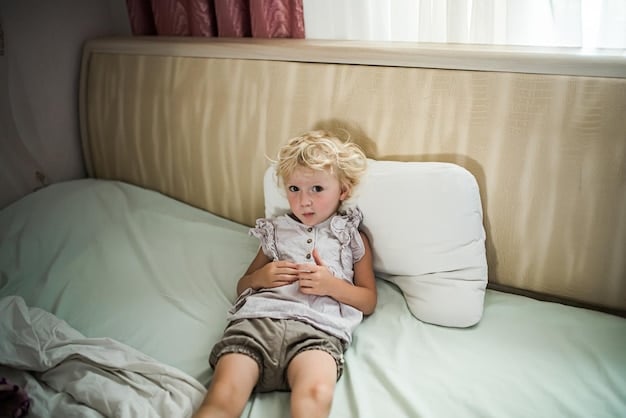Back-to-School Anxiety: Easing Your Child’s Transition in August 2025

Back-to-school anxiety can significantly impact children as they anticipate the academic year; preparation involves open communication, establishing routines, and creating a supportive home environment to ensure a smoother transition in August 2025.
The approach of a new school year can be met with mixed emotions, especially when it comes to children experiencing back-to-school anxiety: how to prepare your child for a smooth transition in August 2025 is crucial for their wellbeing.
Understanding Back-to-School Anxiety
Back-to-school anxiety is a common concern for many children and their parents. It’s essential to understand the roots of this anxiety to address it effectively. This section dives into the nature of back-to-school anxiety, helping you recognize its causes and manifestations.
What is Back-to-School Anxiety?
Back-to-school anxiety refers to the stress, worry, or fear that children experience before returning to school after a break. It’s a very real emotional response and can manifest differently in each child.
This feeling can be triggered by a variety of factors, ranging from academic pressures to social uncertainties.
Common Causes of Anxiety
The causes of this anxiety vary from child to child, but several factors are commonly identified as triggers. Knowing these can help you identify what to expect.
Changes in routine, academic pressure, the fear of new teachers or classmates, and worries about bullying are some of the common triggers. It’s crucial to actively listen to your children.
- Changes in routine can disrupt a child’s sense of security and predictability.
- Academic pressure adds stress, particularly for those concerned about grades or performance.
- Social challenges, like making new friends or navigating peer relationships, are common anxiety triggers.
- Worries about safety, including bullying or feeling unsafe in the school environment, can significantly contribute to anxiety.
By understanding potential causes, you’re better equipped to support your child through these feelings.
Understanding the triggers and knowing what to expect is very useful.
Recognizing the Signs of Anxiety
Identifying anxiety in your child requires careful observation and awareness. The signs of anxiety can vary, but recognizing them is crucial for providing timely support. This section explores the subtle and not-so-subtle indicators of back-to-school anxiety.
Behavioral Changes
Behavioral changes can often signal underlying anxiety in children. These changes might manifest in several ways, and it is important to recognize them.
Increased irritability, difficulty concentrating, changes in sleep or eating habits, and social withdrawal are among the changes you may observe. Paying close attention to these deviations from your child’s norm can offer valuable insights into their emotional state.
Physical Symptoms

Anxiety doesn’t always manifest emotionally; physical symptoms are also common indicators. Recognizing these can help you connect the dots and provide effective support.
Headaches, stomachaches, nausea, and fatigue can be physical manifestations of anxiety. It’s important not to dismiss these symptoms as mere complaints, but to consider them as possible signs of underlying emotional distress.
- Frequent stomachaches or headaches, with no apparent medical cause, can be indicators of stress.
- Difficulty falling asleep or staying asleep, possibly due to racing thoughts or worries.
- Changes in appetite, such as decreased eating or compulsive overeating, linked to emotional regulation.
- Increased complaints of fatigue or low energy, not explained by physical exertion.
Remember, physical symptoms might be a sign of an emotional state.
By acknowledging these emotional and physical signs, you can begin to support your child effectively.
Creating a Supportive Home Environment
A supportive home environment plays a crucial role in helping children manage back-to-school anxiety. Establishing consistent routines, fostering open communication, and practicing relaxation techniques together can make a significant difference. This section discusses ways to build a home where children feel safe, understood, and prepared.
Establishing Consistent Routines
Routines provide structure and predictability, which can greatly reduce anxiety. Establishing consistent routines is very important for the family stability.
Set regular bedtimes, meal times, and study schedules to help your child feel more secure. Consistent routines offer a sense of control, which can alleviate the uncertainties that fuel anxiety.
Open Communication Channels
Encouraging open communication ensures that your child feels comfortable sharing their concerns. Effective communication can reduce anxiety and is a great habit to have.
Make time for daily conversations where your child can express their feelings without judgment. Active listening and empathy are essential in fostering a safe space for them to share their worries.
- Establish a specific time each day for conversations.
- Practice active listening, mirroring back what you hear.
- Validate their feelings, even if they seem small to you.
- Avoid interrupting or dismissing their concerns.
Creating an environment of trust and understanding is very important for your child.
Creating consistency and making sure your child can talk freely greatly improve their ability to deal with anxiety.

Practical Tips for Preparing Your Child
Preparing your child practically involves a combination of planning and reassurance. From school supply shopping to easing back into academic routines, each step can be approached with mindfulness and care. This section outlines concrete tips to help your child feel ready and confident for the new school year.
Involving Your Child in Preparations
Involving your child in the preparations for school can reduce their anxiety and increase their excitement. It can even be a fun family bonding experience.
Take them shopping for school supplies, let them choose their outfits, and involve them in organizing their study space. By actively participating in these tasks, they feel more in control and connected to the upcoming school year.
Easing Back into Academic Routines
A gradual transition back into academic routines can reduce the shock of returning to school. This avoids high stress moments and ensures they go back on their own terms.
Start reviewing academic material a few weeks before school starts, schedule practice study sessions, and gradually increase the time spent on homework. Easing back into routines reduces academic-related anxiety and sets them up for success.
Here are some strategies to follow:
- Review summer reading lists together, discussing favorite parts.
- Assign short practice assignments to refresh their memory.
- Set up a dedicated, organized study area in their room.
- Gradually increase the time spent on academic tasks each day.
Helping them transition back into a routine can be very effective.
Involving your child and transitionning them slowly ensures they ease back into the academic year.
Working with the School
Collaborating with the school is vital in addressing your child’s anxiety. Open communication with teachers, counselors, and administrators can provide additional support and resources. This section explores ways to work together with school staff to ensure a smoother transition for your child.
Communicating with Teachers and Counselors
Establishing an open line of communication with teachers and counselors can greatly benefit your child. This guarantees that they have enough support for a new school environment.
Schedule meetings with teachers to discuss your child’s anxiety, share insights, and develop a unified approach. Connect with school counselors to explore additional support resources like counseling sessions or peer groups.
Utilizing School Resources
Schools offer a range of resources to support students’ emotional well-being. Learning to use these can be a life saver!
Explore programs like counseling services, peer support groups, mindfulness workshops, and special accommodations for students with anxiety. Utilize these resources to provide additional care and assistance for your child.
Effective communication, when needed, is something to be thought about:
- Schedule a meeting with your child’s teacher before school starts.
- Inquire about any available counseling services or support groups.
- Understand the school’s policies regarding bullying and safety.
- Establish a communication plan for updates and concerns.
Using the schools resources will certainly help.
By communicating with the school you make sure that your child is not alone in handling their anxiety.
Seeking Professional Help
Sometimes, despite your best efforts, professional guidance may be necessary to manage your child’s anxiety. Knowing when and how to seek professional help can provide valuable support and strategies. This section discusses the importance of seeking expert advice and what to expect from professional interventions.
When to Seek Professional Help
Recognizing when anxiety requires professional intervention is crucial for your child’s well-being.
If anxiety interferes with your child’s daily functioning, academic performance, or social interactions, it’s time to consult a mental health professional. Persistent symptoms, like severe panic attacks, constant worrying, or social withdrawal, warrant expert evaluation and support.
Types of Professional Help
Various types of professional help are available to address different aspects of anxiety.
Cognitive-behavioral therapy (CBT), medication, family therapy, and counseling are effective interventions. Mental health professionals can tailor a treatment plan to suit your child’s unique needs, helping them develop coping skills and resilience.
Effective professional help can sometimes be beneficial:
- Cognitive-behavioral therapy (CBT) focuses on changing thought patterns.
- Medication may be prescribed for more severe cases, under careful monitoring.
- Family therapy addresses dynamics that contribute to anxiety.
- Counseling provides a safe space for children to express and process their feelings.
These can assist with getting the right professional help.
Knowing when and how to get professional help is another way to ensure your child feels safe.
| Key Point | Brief Description |
|---|---|
| 📢 Open Communication | Establish a safe space for your child to express their feelings and concerns openly. |
| 📅 Consistent Routines | Maintain regular bedtimes, meal times, and study schedules to provide structure. |
| 🎒 School Collaboration | Communicate with teachers and counselors to support your child’s well-being. |
| 👨⚕️ Professional Help | Seek expert advice if anxiety interferes with daily functioning or social interactions. |
Frequently Asked Questions
What are some common signs of back-to-school anxiety in children?
Question
Increased irritability, changes in sleep or eating habits, physical symptoms like headaches or stomachaches, and social withdrawal are common signs.
.
How can I create a supportive home environment for my child during this transition?
Question
Establish consistent routines, promote open communication, practice relaxation techniques, and validate their feelings without judgment.
.
How can I prepare my child practically for going back to school?
Question
Involve them in school supply shopping, ease back into academic routines gradually, and help them organize their study space.
.
What should I do if my child’s anxiety seems overwhelming or persistent?
Question
Consult a mental health professional for expert evaluation and support. Cognitive-behavioral therapy (CBT) and counseling can be very effective.
.
How can communication with the school help manage my child’s anxiety?
Question
Schedule meetings with teachers and counselors to share insights, develop a unified approach, and utilize available support resources like counseling services and peer groups.
.
Conclusion
Easing back-to-school anxiety involves creating a supportive environment, preparing your child practically, and maintaining open communication with the school. While these steps can reduce anxiety, remember that seeking professional help is a valuable option if symptoms persist. With these strategies, you can ensure a smoother transition for your child in August 2025, setting them up for a happy and successful school year.





